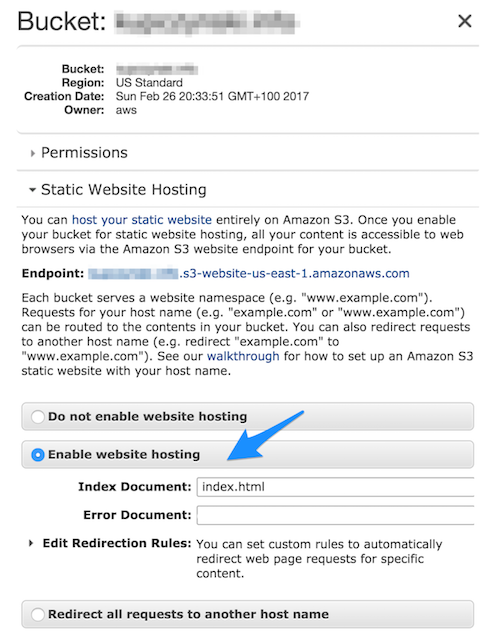Some AWS API quirks make it hard to use folder level index documents via terraform.
If you use a static blogging software like jekyll or hugo you may be tempted to host them on S3. It is simple, cheap and has a great availability (lets ignore the recent us-east-1 incident for now).
The static blogging software relies on the fact that you can use
index.html as a folder root resource. For example if you want to
check the articles tagged as elasticsearch on this blog under the
/tag/elasticsearch/ url you are in fact viewing
/tag/elasticsearch/index.html generated by jekyll. Lucikly for us it
is easy to set up S3 in a website mode which does just that.
The terraform config may look like this:
resource "aws_s3_bucket" "storage_bucket" {
bucket = "${var.domain}"
website {
index_document = "index.html"
}
# (...) ommited for brevity
}
As you can see we specify the index_document which acts as a folder
index document. This results in a following bucket, which responds
with /folder/index.html when you ask for /folder.
Note that this is not an http redirect.

Please also note that we have to access this bucket by through its
website endpoint ${bucket-name}.s3-website-us-east-1.amazonaws.com
otherwise the index_document feature is not going to work.
As a next step we are tempted to use a CDN, like AWS Cloudfront.
Again, the config seems to be quite simple.
resource "aws_cloudfront_distribution" "cdn" {
origin {
domain_name = "${aws_s3_bucket.storage_bucket.bucket_domain_name}"
origin_id = "origin-${var.domain}"
}
default_root_object = "index.html"
# (...) ommited for brevity
}
If you use AWS console instead of terraform you will end up with
something similar. Unfortunatelly, this doesn’t work well with
static websites relying on the fact that for folder resources their
index.htmls are displayed.
The issue with this config is the different way of handling root objects (or index documents if you will) between S3 in website mode and Cloudfront - the former applies it to all folders but the latter only to the root resource and not for the folders. As per the docs
However, if you define a default root object, an end-user request for a subdirectory of your distribution does not return the default root object. (…) CloudFront will not return the default root object even if a copy of index.html appears in the install directory.
To solve this problem we need to point Cloudfront directly to the website endpoint of the S3 bucket. We can change the
domain_name = "${aws_s3_bucket.storage_bucket.website_endpoint}"`.
Simple, right? Unfortunately, this results in an error:
The parameter Origin DomainName does not refer to a valid S3 bucket.
Seems this is an AWS API idiosyncrasy. By default it insists on pointing Cloudfront to the S3 domain endpoint, not the website endpoint.
Adding some secret source and our CDN is ready
resource "aws_cloudfront_distribution" "cdn" {
origin {
domain_name = "${aws_s3_bucket.storage_bucket.website_endpoint}"
origin_id = "origin-${var.domain}"
custom_origin_config {
origin_protocol_policy = "http-only"
http_port = "80"
https_port = "443"
origin_ssl_protocols = ["TLSv1"]
}
}
default_root_object = "index.html"
# (...) ommited for brevity
}
Specifying custom_origin_config forces AWS API to consider the S3
bucket a proper website and correctly forwards the /folder requests
to S3 website endpoint which responds with the content of
/folder/index.html.
This stackoverflow answer helped to solve the mystery.
By the way, you can find my terraform module that I use to host this blog (and some other websites) on my github
>> Home